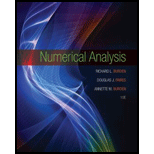
The Maclaurin series for the arctangent function converges for −1 < x ≤ 1 and is given by
- a. Use the fact that tan π/4 = 1 to determine the number of n terms of the series that need to be summed to ensure that |4Pn(1) − π| < 10−3.
- b. The C++ programming language requires the value of π to be within 10−10. How many terms of the series would we need to sum to obtain this degree of accuracy?
Want to see the full answer?
Check out a sample textbook solution
Chapter 1 Solutions
Numerical Analysis
- A television network earns an average of $14 million each season from a hit program and loses an average of $8 million each season on a program that turns out to be a flop. Of all programs picked up by this network in recent years, 25% turn out to be hits and 75% turn out to be flops. At a cost of C dollars, a market research firm will analyze a pilot episode of a prospective program and issue a report predicting whether the given program will end up being a hit. If the program is actually going to be a hit, there is a 75% chance that the market researchers will predict the program to be a hit. If the program is actually going to be a flop, there is only a 30% chance that the market researchers will predict the program to be a hit. What is the maximum value of C that the network should be willing to pay the market research firm? Enter your answer in dollars, not in million dollars. $ __________ Calculate EVPI for this decision problem. Enter your answer in dollars, not in million…arrow_forwardEvaluate the line integral sin z dz, So sin where C is the portion of the curve y = x² from 0 to −1 + i.arrow_forwardLet f(z) be complex differentiable everywhere in C. Fix two distinct complex numbers a and b and a circle C of radius R with |a| < R,|b| < R traversed in the counter-clockwise direction. Evaluate the integral Sc − f(z)dz (z - a)(z – b) in terms of a, b and the values of f at those points.arrow_forward
- | Let C be a circle (with a positive radius) such that z = 1 lies in its interior. Evaluate the contour integral So Tz zez (z - 1)³ = where C is traversed in the clockwise direction. dzarrow_forwardquestion 8arrow_forwardTwo construction companies are bidding against one another for the right to construct a new community center building. The first construction company, Fine Line Homes, believes that its competitor, Buffalo Valley Construction, will place a bid for this project according to the distribution shown in this table: Buffalo Valley's Bid Bid Probability $160,000 0.2 $165,000 0.5 $170,000 0.2 $175,000 0.1 Furthermore, Fine Line Homes estimates that it will cost $160,000 for its own company to construct this building. Given its fine reputation and long-standing service within the local community, Fine Line Homes believes that it will likely be awarded the project in the event that it and Buffalo Valley Construction submit exactly the same bids. Find the bid that maximizes Fine Line’s expected profit. Max expected profit $ ________ . Bid that maximizes profit $ ________ .arrow_forward
 Algebra & Trigonometry with Analytic GeometryAlgebraISBN:9781133382119Author:SwokowskiPublisher:Cengage
Algebra & Trigonometry with Analytic GeometryAlgebraISBN:9781133382119Author:SwokowskiPublisher:Cengage

